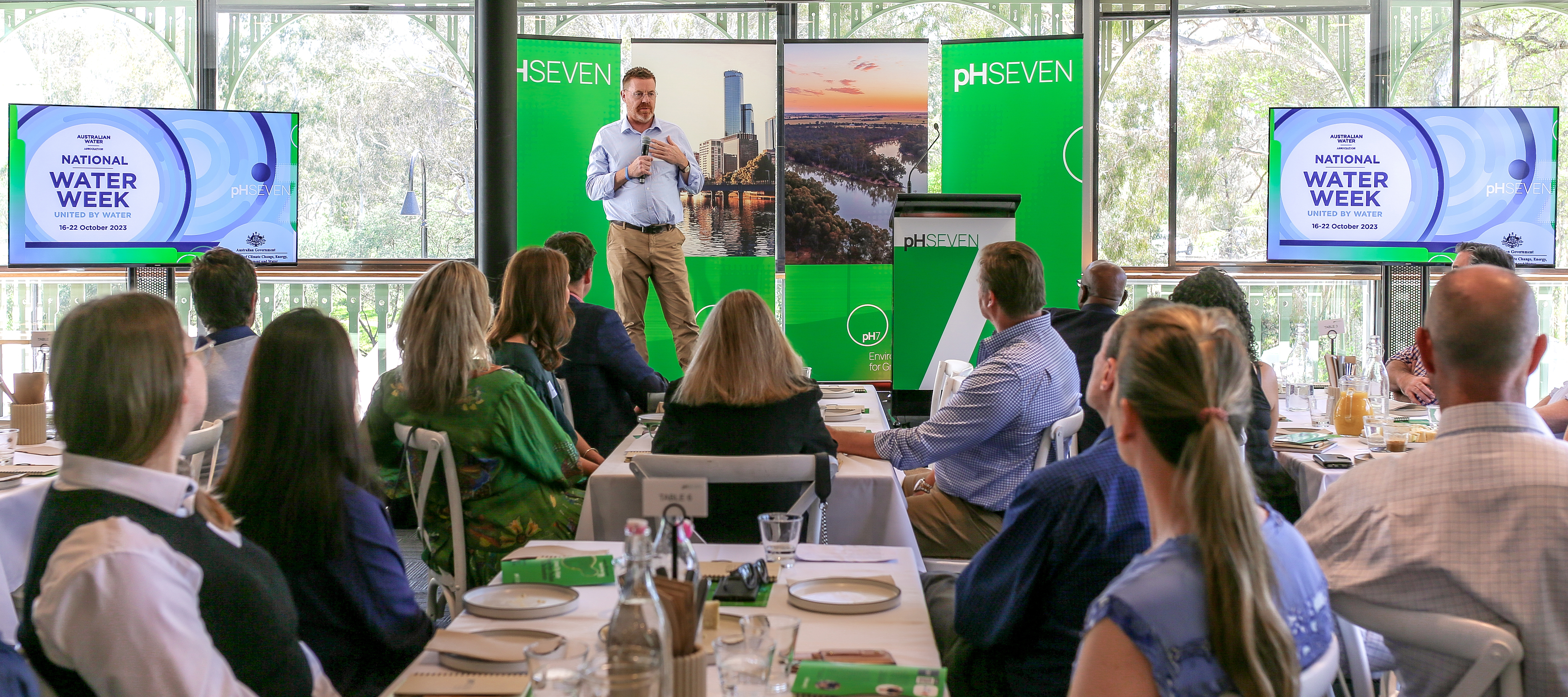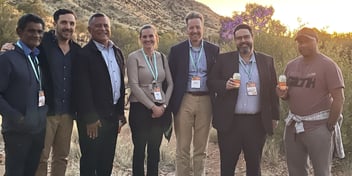United by Water: working together to overcome the extremes of climate change

As regions around Australia continue to grapple with damaging floods and droughts, the increasing variability and intensity of extreme weather events under climate change is inspiring communities to band together to achieve resilient outcomes.
Marking one year since the devastating 2022 floods in Victoria, and commemorating the courageous efforts of communities impacted, water specialists gathered in Melbourne last month for an event to share experiences, discuss climate challenges and reflect on the importance of community in achieving positive outcomes.
Held during National Water Week and hosted by pHSEVEN, ‘United by Water: Voices From The Bush To The Boardroom’ presented an array of personal stories, science and insights from people working on the frontline of extreme weather, climate change, policy and planning, and community resilience and recovery.
Beyond Blue Ambassador Brad McEwan guided attendees through presentations from guest speakers, including University of Melbourne’s Professor Rory Nathan, and Dr. Lisa Ehenfried and Alice Greenhill from Yarra Valley Water.
FIFTEEN50 Consulting Director Matt Barden and Coolibah Turf owner Suzie Shearer also shared their experiences.
Professor Rory Nathan said Australia is in a unique position when it comes to dealing with the impacts of climate change due to the continent’s natural climatic variability, which is expected to get more extreme in future.
“Australia has a highly variable climate compared to other countries. Our climate swings from extended droughts to drenching floods, and in between we are prone to bushfires. From one month to the next, and one year to the next, our streamflows are the most variable in the world,” he said.
“The concept of ‘average climatic conditions’ in Australian hydrology is largely irrelevant. It’s like telling someone, who's standing in a bucket of ice water with their head on fire, that their average temperature is fine. It’s not a useful or meaningful statistic.
“Australia’s climate swings from drought to flood and then back again, and these extremes will intensify under climate change. We need to be thinking about climate change as a crisis of variability; a crisis of extremes. The new normal will contain fewer years of what we think of as being ‘average’.”
The new normal
When it comes to what can be expected as the climate continues to change, Nathan said there is a double whammy with floods.
“There are two things happening. Under climate change in our part of the world, big floods will get bigger and small floods are going to get smaller,” he said.
“The inflows to our reservoirs are derived largely from small floods. We need these flow pulses to top up our reservoirs, but with drying soils these small floods are going to reduce, and this will put added stress on our water supplies.
“The second issue is that with warming temperatures the atmosphere can hold more moisture, and this means that extreme rainfalls will intensify, so big floods are likely to get bigger.”
With flood risk increasing due to climate change, Nathan said the solution will likely not be found in engineering solutions alone, but will also require increased levels of community resilience.
“When is Lismore going to get its next flood? When is Rochester going to get its next flood? We can’t answer such questions. But we can estimate how flood risks are changing over time, and this will help us to better plan and adapt to these future changes,” he said.
“Building bigger dams and levees can only achieve so much. There are nature-based solutions that we can implement at a catchment scale, and we will also need a mix of engineering, planning, and softer solutions.
“We are going to have to get better at living with floods, and this will necessarily involve raising community awareness, and implementing measures that will increase social and community resilience.”
Dealing with drought
Discussing the post-colonial history of water management in Australia, FIFTEEN50 Consulting Director Matt Barden said the country has swept through development of infrastructure, through management and adjustment, before coming to the current period of reform.
“The National Water Initiative (2004) underpinned the water reform plan for the Murray-Darling Basin. The reform program was ultimately about moving water from land application back to the environment,” he said.
“Then the Millennium Drought passed over and the game was up. For me, the period of 2006 to 2009 was a period of really significant change in reform, and at a pace that was unprecedented in Australian water management.
“The Millenium Drought sparked a huge response in investment, we saw a lot of spending to ensure that people could still maintain critical human needs.
“That’s the first time in my career that I can recall seeing such a significant deviation within the water space. There was genuine resentment in how water was being managed. It was a challenging space to be in.”
Barden said one thing he learned from working within water during the Millenium Drought is that it’s all well and good to have a plan for reform, but implementing it is not always easy.
“The Murray Darling Basin Plan was implemented in 2012 and its key objective is to deliver water from the consumptive pool through a range of different mechanisms to ensure that the environment has an enshrined right in perpetuity to water across the entire Basin,” he said.
“It’s a huge area of land and a huge reform agenda. And a huge impact as far as dealing with moving water away from irrigation communities.
“Having a policy platform can be quite easy, but exercising and implementing it is quite often very difficult. There is tension in the debate around conservation versus irrigation.”
Barden said empowering communities with information about what these reforms will mean for them is an area of climate change mitigation that needs more work.
“Do we actually explain the solution to the problem clearly? In my experience, we quite often are not investing in understanding exactly what that impact looks like and the response to that,” he said.
“We have seen an acceptance in the bush that the environment needs to be maintained. We need a healthy ecology. There isn’t a resistance to having environmental water. People want to see local benefits from the application of that water in their local area.
“There is common ground. Water is life and there is unity within that. That expectation, doesn't matter where you are, is consistent across communities.”
Working together
Meditating on her own experiences of being an agri-business owner during the Millenium Drought, Coolabah Turf’s Suzie Shearer said the event significantly impacted her business, but also her motivation to fight forward.
“Water and unity are not new conversations for me or my industry. Even though the core of our family farming enterprise is in turf production, I spent my first ten years in business talking about water,” she said.
‘’This is a conversation so vital to ensure we are working hard together as an industry collective.
“Our business was established in 2001, at the beginning of the Millenium Drought. I spent the first 10 years of business talking to customers about water storage capacity in tanks in residential backyards, lobbying governments, and countless nights away from my young family, sitting on local and national industry boards.
“I have a photo of my boys taken the first time they saw rain falling from the sky. It sits at home as a reminder of never taking water for granted. They were five, four and three before they experienced a proper rain event.”
Despite battling through some gruelling years, Shearer said the decision was made to innovate, adapt, and to work together as an industry and a community to forge a way forward.
“We loved Echuca and we loved our industry. We knew we had to get better in the game or get out of the game, so we got busy,” she said.
“We refined our product range and streamlined our production practices, which meant we could start specialising in water-smart, drought-tolerant turf that could be grown with significantly less water.
“But we also united as an industry to help each other navigate a really challenging period of uncertainty.
“During the darkest days of drought, players in the Victorian turf industry sat around a boardroom table as a collective and hatched a plan to unite our voice to take the issue to government.
“We successfully lobbied urban water authorities to provide 28-day water exemption permits for homeowners to establish new lawns. This was a real lifeline. I then spent the next five years working with customers to educate them on how to establish and sustain lawn landscapes with minimal water.”
Shearer said she hopes her story stands as a reminder that communities and industries are powerful, and, with a united voice, can steer the future of water management in the right direction to create liveable cities and vibrant communities for the future.
“Everyone here today has the power to influence meaningful outcomes for long-term water security for the community,” she said.
“Our grandchildren’s children are relying on us to ensure long-term access to adequate volumes of an affordable water system to protect and create sustainable landscapes.”



